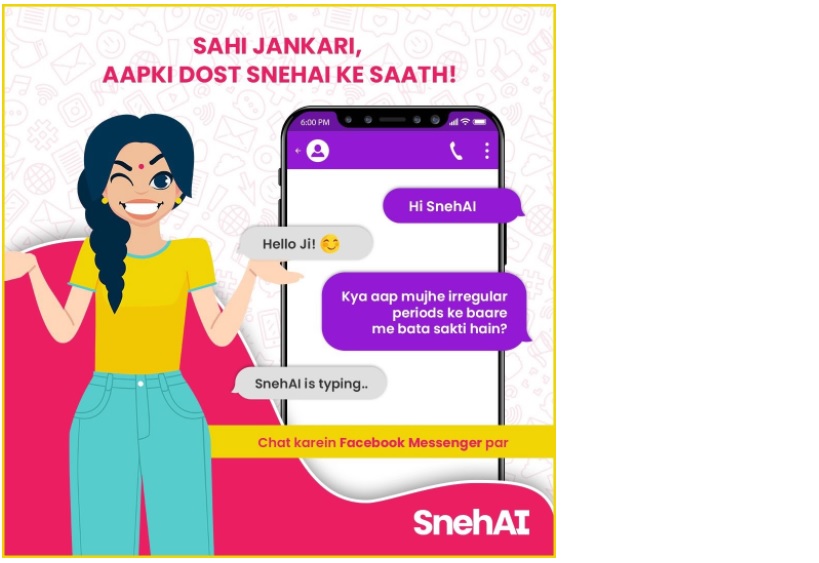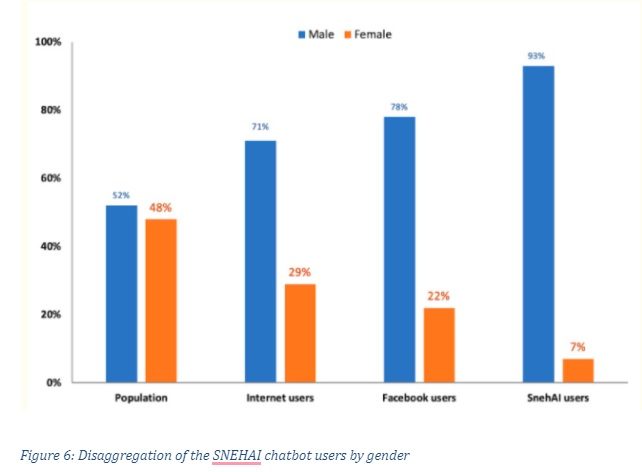EVALUATION AND RESULTS
The aggregate dashboard analytics data on SnehAI user behaviors was examined over a period of 5-month. A total of 8,170,879 messages were exchanged between SnehAI and 135,263 unique chatbot users, including 5,100,449 (62.42%) outgoing messages from the chatbot to the users and 3,070,430 (37.58%) incoming messages from the users to the chatbot. The ratios between outgoing and incoming messages were consistently around 60:40 over time, with the exception of repeated outgoing messages in July (such as technical errors). Specifically, incoming messages from the users to the chatbot were sent through free texts (1,599,339/2,878,908, 52.09%); clickable reactions (1,279,569/2,878,908, 41.67%); or GIFs, audios, images, and videos (191,522/2,878,908, 6.24%).

The average user engagement with SnehAI was 1.9 sessions, 7.6 minutes, and 56.2 messages exchanged. The time spent by top users increased from 2 to 3 hours in the first 3 months to 7 hours in 14 sessions in August and 14 hours in 47 sessions in September.

User engagement was also tracked through the content categories, including both guided flows using clickable reactions and the handling of free-text messages using NLP. From onboarding to learning about SnehAI, to its privacy policy, and its main menu to the videos, stories, games, helplines, and query responses through NLP, the chatbot users traversed across these content areas for 1,430,416 times over the course of 5 months. Approximately half (705,305/1,430,416, 49.31%) of these interactions were about the chatbot responding to the user queries, including small talks and any questions related to themes of health communication. The next highest frequency content category was user enrolment (257,042/1,430,416, 17.97%), about SnehAI (115,131/1,430,416, 8.05%), privacy policy (96,305/1,430,416, 6.73%), main menu (83,692/1,430,416, 5.85%), helplines (71,211/1,430,416, 4.98%), stories (61,582/1,430,416, 4.31%), games (20,897/1,430,416, 1.46%), and videos (19,251/1,430,416, 1.35%). These trends in content engagement distribution were relatively consistent (with occasional fluctuations).

Our analytics tracking data showed a count of 99,936 typed text messages from the users that SnehAI handled and responded through the NLP system with queries related to the six topical themes 
safe sex practices, such as consent, frequency of sexual intercourse, oral and anal sex, impact of other health ailments on sex life, and unplanned pregnancy (57,158/99,936, 57.19%); choice of family planning methods, such as male and female condoms, oral contraceptive pills, intrauterine devices, injectables, and SRH-related themes, such as abortion, sexual intercourse during and after pregnancy, polycystic ovarian disease, and infertility issues (6287/99,936, 6.29%); female reproductive health concerning menstruation (e.g., regularity, pain, discharge, and spotting), virginity, and premarital sex (13,965/99,936, 13.97%); adolescent sexual health issues, such as nightfall, masturbation, pornography, sexual stamina, erectile dysfunction, and STIs (15,160/99,936, 15.17%); adolescent mental health issues regarding peer pressure and bullying (2343/99,936, 2.34%); and nutrition and social determinants of health, such as child marriage and gender equality (4623/99,936, 4.63%).
SnehAI chatbot user gender-disaggregated data revealed an extreme gender gap
among the unique chatbot users over the 5-month period, 93% (125,795/135,263) were male, 6.8% (9198/135,263) were female, and 0.2% (270/135,263) unknown. This gender ratio was disproportionally skewed toward male users compared with that in the United Nations Development Programme report on the gender distribution of internet users (29% female) and Facebook users (22% female) in India [12]. This might be a function of female users facing gender disparities in mobile device ownership and low digital media literacy in India. Also, the 15,000 queries that were sampled by the data science team established a behavioral pattern that revealed that female users exhibited significantly lower self-confidence in their conversations with SnehAI






